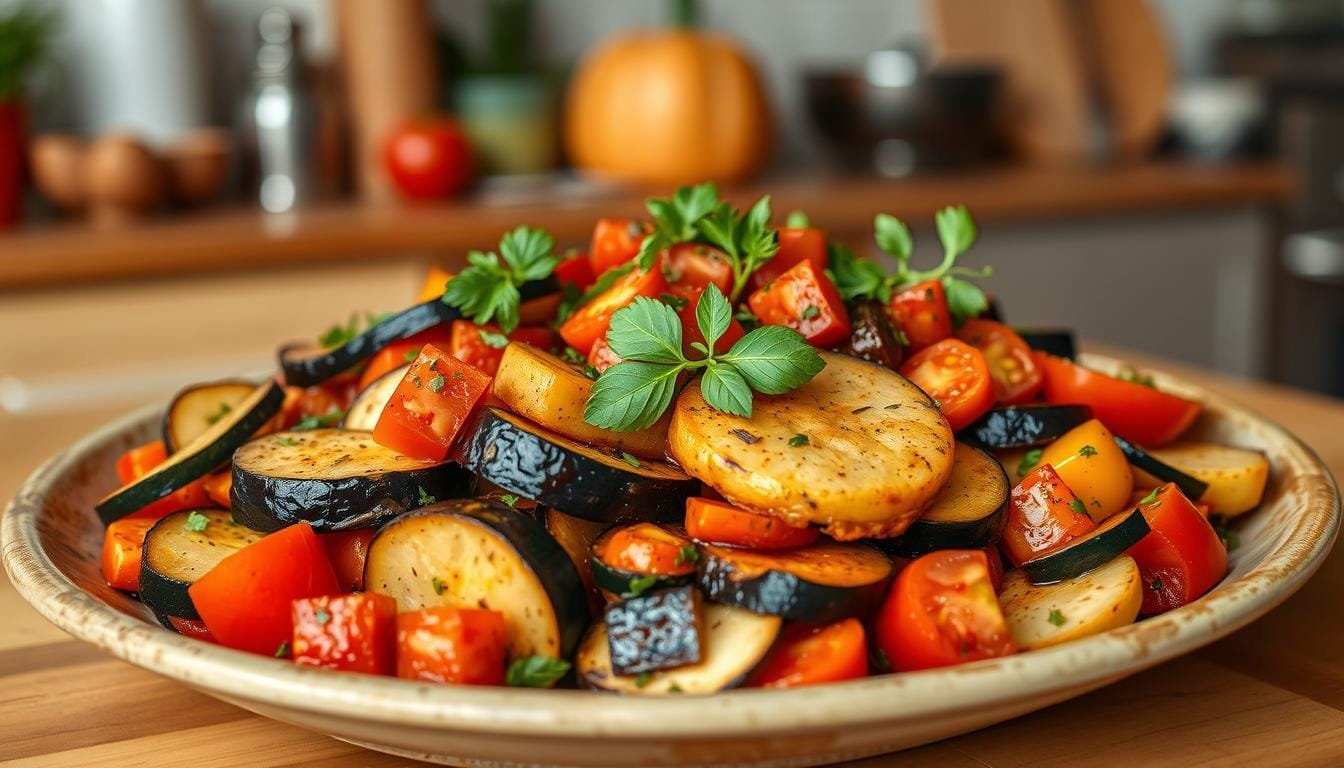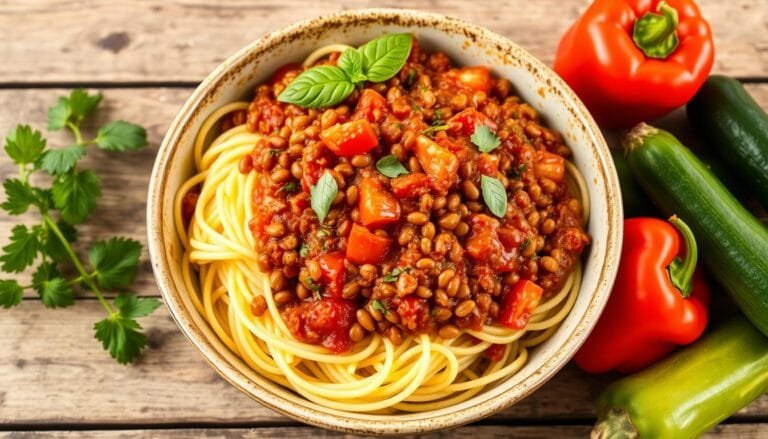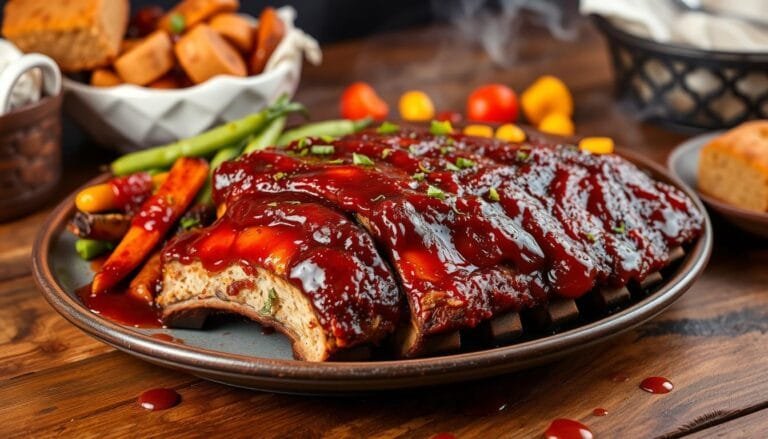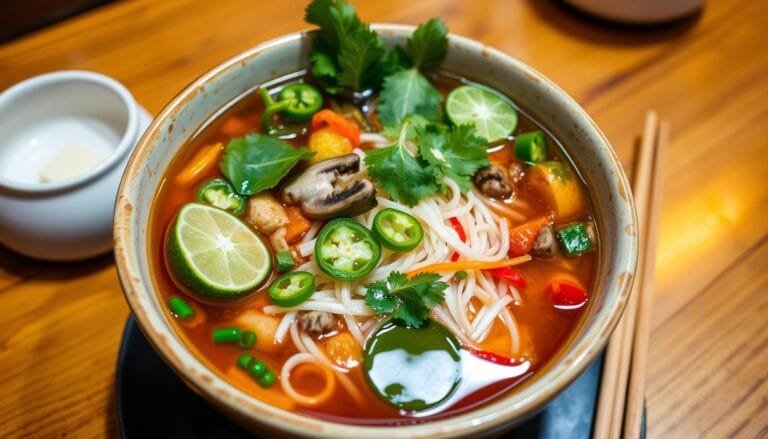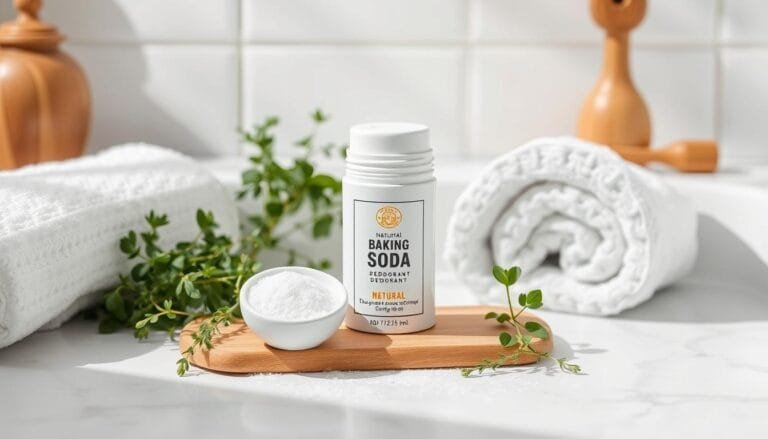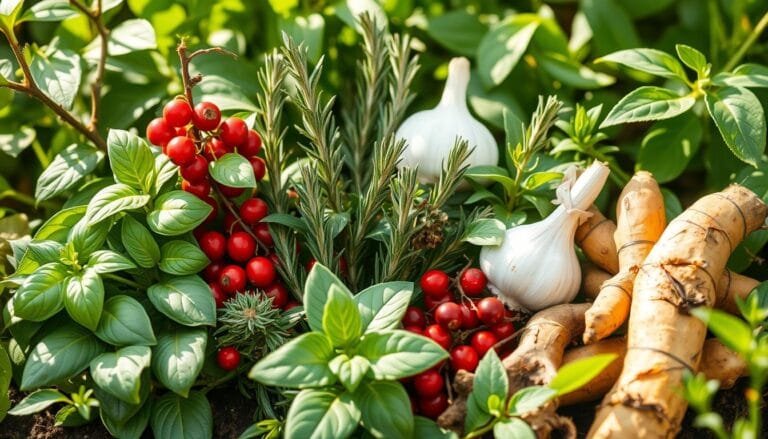I love French cuisine, and ratatouille is my favorite. It’s a colorful dish filled with summer vegetables. It celebrates the Mediterranean’s harvest.
Ratatouille is a plant-based dish. It mixes eggplant, zucchini, yellow squash, bell peppers, and tomatoes in a tomato sauce. You can eat it hot, room temperature, or chilled. It’s perfect for any time.
Ratatouille highlights the sweetness and colors of fresh produce. It’s great for vegans or anyone wanting more plant-based meals. This French stew is a joy to eat.
Making ratatouille is easy. It takes 30 minutes to prepare and about 1 hour and 15 minutes to cook. It’s a family-friendly summer dish. Originally a peasant food, it’s now a Mediterranean icon.
Understanding the Origins of Traditional French Ratatouille
Ratatouille, a beloved French dish, comes from the southern region of France. It started as a simple peasant dish. Now, it’s a culinary icon, deeply rooted in Mediterranean cooking traditions of Provence.
The History Behind Provence’s Beloved Dish
Ratatouille’s story begins in the late 18th century. It was a coarse stew made by poor French farmers. They used local vegetables like tomatoes, garlic, onions, zucchini, eggplant, and bell peppers.
These ingredients were simmered together. This made a flavorful and nourishing dish.
From Peasant Food to Culinary Icon
Over time, ratatouille evolved from a simple dish to a beloved part of French culinary history. It first appeared in print around 1930. Then, it became a refined culinary masterpiece.
Today, ratatouille is a staple in Parisian bistros and restaurants. It shows the versatility and cultural significance of this Provence cuisine classic.
Regional Variations and Cultural Significance
Ratatouille is closely tied to Provence, but similar dishes exist across the Mediterranean cooking traditions. In the South-West of France, there’s piperade. In the South-East, there’s tian. In Castilian-Manchego, Spain, there’s pisto.
These dishes share ratatouille’s flavor profile and preparation. They show the adaptability and cultural significance of this beloved dish.
The 2007 Pixar film “Ratatouille” made the dish famous. The movie’s version, “confit byaldi,” is a vegetable tian arrangement. But, it’s not the traditional stewed ratatouille.
Despite this, the film’s success has made ratatouille a French culinary icon.
Essential Ingredients for Authentic Plant-Based Ratatouille
To make a delicious vegan ratatouille, choose the best Mediterranean vegetables. The dish’s heart is a mix of eggplant, zucchini, yellow squash, bell peppers, onions, and tomatoes. It’s important to pick the freshest, tastiest produce.
Garlic adds depth and aroma. Olive oil brings all the flavors together. Herbs like basil and thyme enhance the dish, matching the vegetables’ flavors.
White wine vinegar adds brightness. A bit of sugar balances the acidity. Don’t use green bell peppers, as they’re not sweet enough.
Use dry white wine or vegetable broth for cooking. This makes the vegetables simmer together, creating a dish full of Mediterranean flavors.
| Ingredient | Amount |
|---|---|
| Eggplant | 2 medium |
| Zucchini | 2 medium |
| Yellow Squash | 2 medium |
| Bell Peppers | 2 red |
| Onions | 2 yellow |
| Tomatoes | 28 oz can |
| Garlic | Minced |
| Olive Oil | 1 Tbsp |
| Basil | Fresh |
| Thyme | Fresh |
| White Wine Vinegar | 1 Tbsp |
| Sugar | 1 tsp |
| Dry White Wine or Veggie Broth | 1 cup |
With these ingredients, you’re ready to make a real, plant-based ratatouille. It will taste like traditional French cooking.
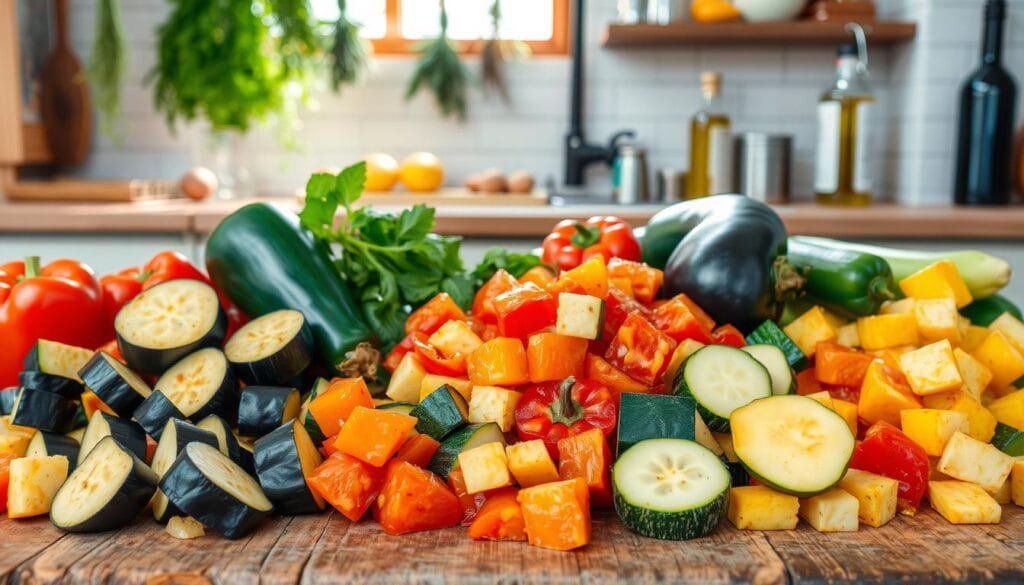
The Art of Preparing Your Vegetables
Making a tasty plant-based ratatouille begins with the right vegetable prep. It’s all about cutting right and pre-cooking tips. These steps are key to getting the perfect texture and flavor in this French classic.
Proper Cutting Techniques
Start by cutting your veggies into the same size pieces. Cut the eggplant and zucchini into 1-inch cubes. Dice the bell peppers into 1/2-inch pieces. This makes sure they cook evenly and look great.
When working with eggplant, don’t forget the eggplant salting step. It gets rid of extra moisture and bitterness.
Pre-cooking Preparation Tips
Before cooking, dry your veggies with paper towels. This is key for a good sear and browning. It adds a lot of flavor to the dish. Also, rub dried herbs between your fingers to release their oils. This boosts the flavor of your ratatouille.
Chop the onions and mince the garlic for the dish’s base. These steps might seem simple, but they greatly improve your ratatouille.
Salt-treating the Eggplant
Don’t skip the salting the eggplant step. It removes excess moisture and bitterness. This makes the eggplant taste better and be more tender. Just toss the eggplant cubes with salt, wait 20-30 minutes, then rinse and dry them.
“Proper vegetable preparation is the foundation for a truly exceptional ratatouille. By taking the time to carefully slice, dice, and salt the produce, you’ll unlock a world of flavor and texture in this beloved dish.”
By learning these prep techniques, you’ll make a plant-based ratatouille that’s not just good-looking but also full of flavor.
Plant-Based Vegetable Ratatouille: Step-by-Step Cooking Process
Making the perfect vegan ratatouille recipe is like creating a work of art. It combines the fresh tastes of vegetables. The stovetop ratatouille method lets you make a delicious one-pot dish, just like French cuisine.
First, get your ingredients ready: eggplant, zucchini, peppers, onions, and a tasty tomato base. Cooking each veggie separately is key. It helps them get the right texture and caramelized flavor.
- Begin by cooking the eggplant in a big skillet or Dutch oven with olive oil. Cook until it’s lightly browned and soft, about 8-10 minutes.
- Then, add the zucchini and cook for another 5-7 minutes. This lets it get a nice sear.
- After that, add the peppers and onions. Cook until they smell good and are slightly soft, about 6-8 minutes.
Now, mix all the veggies together to make the vegan ratatouille flavor. Add crushed tomatoes, garlic, herbs, and spices to the pan. Stir gently to mix everything well. Let it simmer for 20-25 minutes, stirring now and then, until the flavors blend perfectly.
This stovetop ratatouille method takes about 45-50 minutes. This ensures the veggies are tender and the sauce is thick. Keep an eye on the heat to avoid sticking and ensure even cooking.
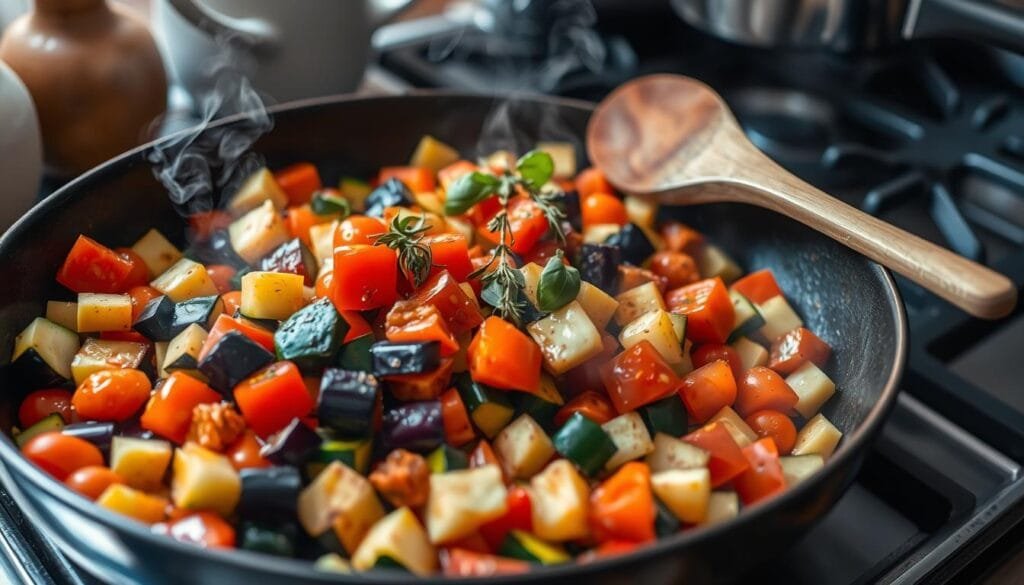
Follow these steps to make a tasty one-pot vegetable dish. It’s a plant-based version of the classic French vegan ratatouille recipe. Enjoy the flavors and the bright colors of this dish.
Mastering the Perfect Tomato Base Sauce
Making the perfect tomato base sauce is key to a great ratatouille. Choose fresh, ripe tomatoes or high-quality canned crushed tomatoes. Adding tomato paste can also enhance the flavor of your sauce.
Choosing the Right Tomatoes
For the best ratatouille base, use fresh, in-season tomatoes or top-notch canned crushed tomatoes. San Marzano D.O.P. tomatoes are a great pick. They add a superior taste to your homemade sauce.
Herb and Seasoning Combinations
Use aromatic herbs to complement the tomatoes’ sweetness. A mix of basil, thyme, and oregano creates a fragrant sauce. Season with salt, pepper, and a bit of red pepper flakes for a hint of heat.
Let the sauce simmer for 8-10 minutes before adding vegetables. This lets the flavors blend. Adding a splash of white wine can add acidity and depth.
“The key to a truly exceptional ratatouille is the foundation of a rich, flavorful tomato base. By carefully selecting the right ingredients and letting the sauce simmer, you can create a sauce that will elevate your entire dish.”
| Ingredient | Quantity |
|---|---|
| Tomatoes (fresh or canned crushed) | 1 1/4 pounds |
| Tomato paste | 2 tablespoons |
| Basil | 1/4 cup, chopped |
| Thyme | 1 teaspoon, chopped |
| Oregano | 1 teaspoon, chopped |
| Salt | 1 teaspoon |
| Black pepper | 1/4 teaspoon |
| Red pepper flakes (optional) | 1/8 teaspoon |
| White wine (optional) | 2 tablespoons |
Traditional vs. Modern Cooking Methods
Ratatouille has been a favorite in France for over a century. The old way is to cook the veggies on the stovetop. This method lets you control the texture of each vegetable. It makes a hearty, rustic ratatouille with rich flavors.
Nowadays, people like to bake the veggies in the oven or make them into a pretty circle, called the “tian” style. Baking makes the flavors more even and takes less work. Some recipes even roast the veggies first to add more taste.
| Cooking Method | Texture | Hands-on Time | Flavor Concentration |
|---|---|---|---|
| Stovetop | Varied | Higher | Robust |
| Oven-baked | Uniform | Lower | Concentrated |
| Tian-style | Visually Appealing | Moderate | Balanced |
Choosing between traditional, oven-baked, or tian-style ratatouille depends on what you like. Whether you stick with the classic stovetop method or try something new, the goal is to enjoy the vibrant tastes and textures of this French dish.
Tips for Achieving the Perfect Texture and Flavor Balance
Creating the perfect plant-based ratatouille requires the right texture and flavor balance. Follow a few simple steps to make your vegetable stew tender yet flavorful.
Temperature Control Guidelines
Keeping the right temperature is key. Cook the vegetables over medium heat. This prevents burning and keeps them tender.
Timing and Layering Techniques
Timing and layering are important for ratatouille perfection. Start with sautéed onions and garlic for flavor. Then, add eggplant and zucchini in stages. This ensures each vegetable is tender.
Let the ratatouille simmer uncovered to concentrate flavors. Taste and adjust seasoning as you go. This balances the flavors well.
Let the dish rest for a few minutes before serving. This allows the flavors to meld. You’ll get tender vegetables in a rich sauce – the perfect plant-based ratatouille.
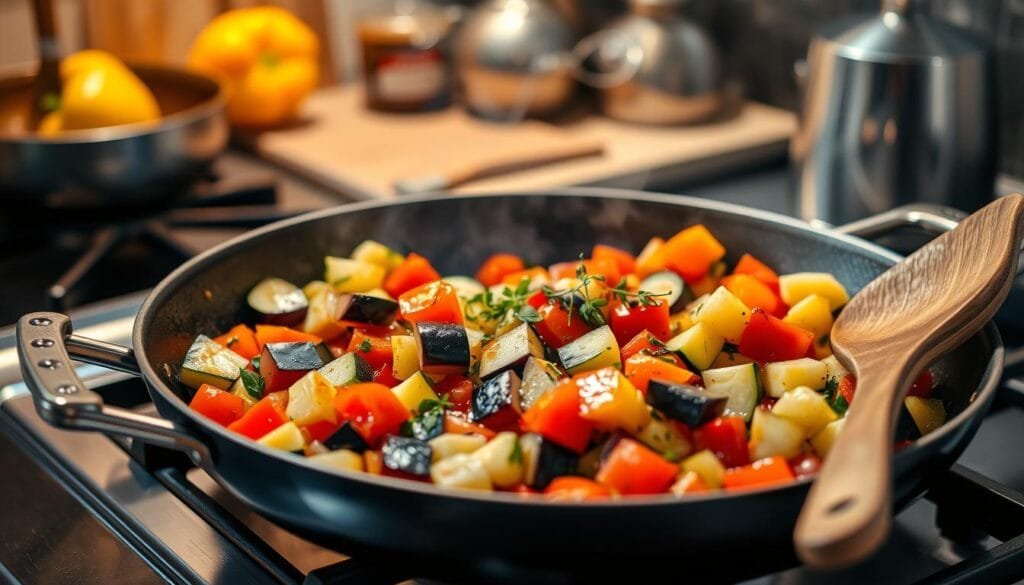
Serving Suggestions and Pairing Options
Ratatouille, a beloved French vegetable dish, is perfect for many meals. You can serve it as a main dish, a side, or part of another meal. There are many delicious ways to enjoy it.
Enjoy ratatouille as a main dish with a crusty baguette, creamy polenta, or steaming hot rice. The vibrant vegetable flavors go well with the hearty starch. It makes for a satisfying meal. For a vegan option, try it over fluffy quinoa or nutty farro.
As a side dish, ratatouille pairs well with grilled or roasted proteins. Try it with juicy chicken, tender lamb, or succulent pork chops. The bright, herbaceous notes of the ratatouille complement the savory meat, creating a balanced plate.
For a refreshing twist, serve ratatouille at room temperature or chilled. It’s perfect for hot summer days. Pair it with a crisp green salad and a glass of chilled white wine or rosé for a light meal. You can also use it as a topping for crostini, making a simple yet elegant appetizer.
To add a touch of indulgence, top your ratatouille with a fried egg or crumbled feta cheese. The runny yolk or tangy cheese will make the dish even more satisfying. It’s great for breakfast or brunch.
Ratatouille is a versatile and delicious French vegetable dish. It can be enjoyed in many ways, whether as a main course, side dish, or part of a larger meal. This plant-based wonder is sure to delight your taste buds and leave you wanting more.
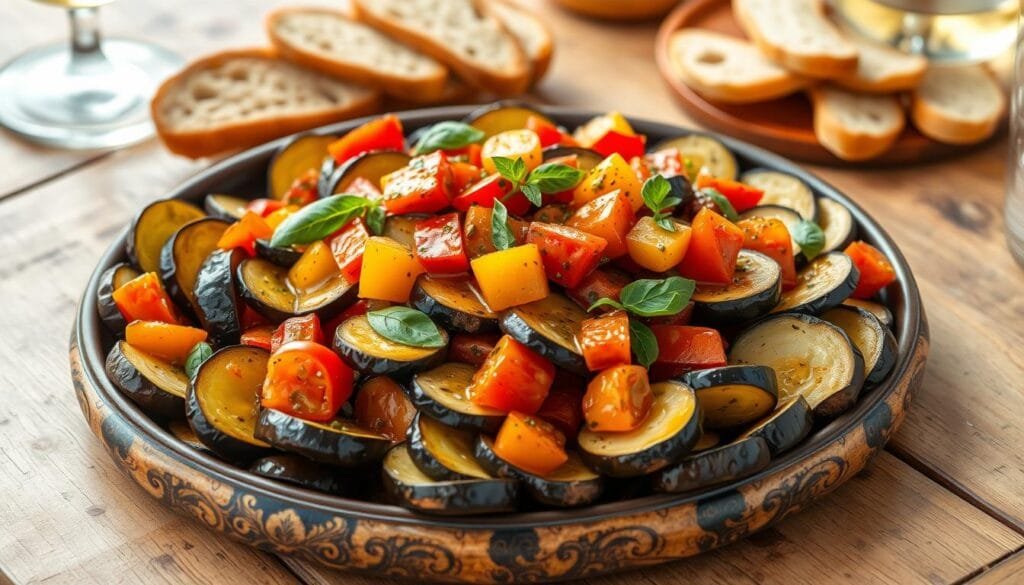
“Ratatouille is a dish that brings people together, whether it’s as a main course, a side, or even a filling for a sandwich. It’s a true culinary celebration of the bounty of the earth.”
Storage and Reheating Guidelines
Plant-based ratatouille is a French classic that’s both tasty and great for meal prep. It’s amazing because it stays fresh for days, letting you enjoy its flavors over and over.
To keep your ratatouille fresh, use an airtight container in the fridge. It will stay good for 4-5 days, getting even better with time. If you want to keep it longer, freeze it in airtight containers for up to 3 months.
Now, it’s time to enjoy your leftover ratatouille. Reheat it gently, using a bit of water or broth to keep it moist. This way, it will taste just as good as when you first made it.
Whether hot or at room temperature, ratatouille is always a treat. So, enjoy every bite of this French favorite, knowing your leftovers will be just as tasty.
Prep Time: 5 minutes
Cook Time: 25 minutes
Total Time: 30 minutes
Servings: 4 servings
Calories: 169 kcal per serving
Average rating: 4.67 out of 5 based on 3 votes
Nutritional information per serving: Carbohydrates 17g, Protein 3g, Fat 11g, Saturated Fat 2g, Sodium 626mg, Potassium 665mg, Fiber 6g, Sugar 10g, Vitamin A 1537IU, Vitamin C 73mg, Calcium 40mg, Iron 1mg.
Health Benefits and Nutritional Information
Ratatouille, the beloved French vegetable stew, is a culinary delight and a nutritional powerhouse. It’s low in calories but packed with vitamins, minerals, and antioxidants. These nutrients offer many health benefits.
One serving of ratatouille has just 161 calories. It’s perfect for those who want to keep a healthy weight. It’s also a good source of fiber, with 8 grams per serving. This fiber aids digestion and keeps you feeling full.
The vibrant colors of ratatouille come from the tomatoes, bell peppers, and eggplant. These vegetables are rich in vitamins A and C. These vitamins boost your immune system, skin health, and eye health. The antioxidants in the eggplant skin and other vegetables protect your cells and lower disease risk.
Ratatouille also has healthy fats from olive oil. These unsaturated fats are good for your heart. It’s also a good source of potassium, with 767mg per serving. Potassium helps control blood pressure and supports muscle and nerve function.
For those on a Mediterranean diet, ratatouille is a great choice. It fits well with the diet’s healthy eating principles. For vegan or vegetarian diners, ratatouille is a tasty source of plant-based protein. Pair it with legumes or whole grains for a complete meal.
Looking to add more ratatouille nutrition facts to your diet? Or just want a delicious, nutritious meal? Ratatouille is a versatile and healthy choice.
“Ratatouille is a celebration of the Mediterranean diet, showing off vibrant flavors and health benefits of fresh, locally-sourced vegetables.”
Seasonal Variations and Ingredient Substitutions
Ratatouille is a versatile vegetable stew that can be made in many ways. It’s not just about zucchini, eggplant, and tomatoes. I love trying out different vegetables based on what’s in season.
For example, if zucchini is hard to find, I use yellow squash instead. Carrots or celery can add more flavor. And potatoes or winter squash make it thicker and more filling. When fresh tomatoes are out of season, canned ones work just as well.
Playing with herbs is another fun part of ratatouille. While thyme and basil are common, oregano, rosemary, or a mix of Mediterranean herbs can change the flavor. Just remember to adjust cooking times so each veggie is tender.
